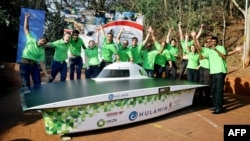Teams from two South African universities have taken solar-powered cars to Australia to compete in an international rally and showcase their government’s efforts to inspire green technology at home.
The Hulamin and the Sirius X25, created by the University of KwaZulu-Natal and North-West University respectively, have already had success in a South African rally.
As they prepare for the Bridgestone World Solar Challenge on October 18-25, the cars’ promoters say the vehicles have left innovation and a desire for clean energy in their wake, sparking interest in engineering, and particularly in electric vehicles.
The two universities are among five that in 2012 each received 330,000 rand ($24,000 at today’s exchange rate) from the South African government’s Technology Innovation Agency to develop vehicles and compete in the Sasol Solar Challenge, an eight-day race from Pretoria to Cape Town held in 2014.
Local and international teams vied for national and international records for the farthest distance travelled per day and total distance covered.
The two cars that are now readying for battle in Australia were among the winners.
Solar races, powering education
According to Winstone Jordaan, who started the Sasol Solar Challenge in 2008, more than 2,000 students have been involved with solar car teams, either developing the cars at the universities, managing the teams’ logistics and finances or helping as rally organizers.
Jordaan estimates that at least 100,000 secondary-school pupils and university students and researchers have been exposed to the races, and he hopes some of them would now consider engineering as a career.
"We see a much better understanding of solar and electric vehicle technology,” he said. One measure of success, he said, will be “more children wanting to study engineering and the sciences.”
Albert Helberg, North-West University’s program coordinator and solar team manager, points to both rising student interest in engineering and the increasing number of small industries engaging in electric vehicle projects as the strongest evidence of the impact of the solar cars.
Small and medium-sized companies have approached North-West University to make agreements to collaborate on innovative products in renewable energy, he said.
The public in South Africa is becoming more aware of solar energy, he said, in part because of continuing shortages of traditional power from the country’s main electricity grid supply.
According to Tobias Bischof-Niemz of the Council for Scientific and Industrial Research, about 25 solar plants today contribute 1,000 megawatts of power to the national grid.
Southern Africa drive
The University of Johannesburg also has been taking the green technology message on the road. Parked outside its solar laboratory is the Ilanga II.
Engineering and industrial design students built the solar car, which is named after the sun in the isiZulu language, in 2013 to compete in the 2014 Sasol Solar Challenge.
Following improvements to the car from a new generation of students this year, the Ilanga II left Johannesburg last June for a 4,160 km (2,600-mile) educational road trip dubbed the 2015 African Solar Drive.
The trip saw 20 students from the engineering and humanities faculties taking turns at the wheel. The route passed through Namibia before ending in Gaborone, the capital of Botswana.
Along the way, the team made stops in communities and at higher education institutions, meeting students, academics and the public.
"The vehicle is used as a platform to promote renewable energy, demonstrating what can be done and inspiring communities to imagine a clean future and to build it themselves,” said Nickey Janse van Rensburg, a program manager for the university clean energy project.
Janse van Rensburg said the team was pleasantly surprised to see that some of the communities they visited had already adopted green energy solutions, including rooftop solar lighting and solar water heating.
During the road trip, she added, students collected and analyzed data to optimize the performance of the vehicle in preparation for an attempt to set the solar land-speed record in 2016.
Learning platform
"For us, Ilanga is a technology platform to develop students and technology and promote energy innovation, similar to what F1 racing does for the motor industry,” said Janse van Rensburg, who also lectures in mechanical engineering science at the university.
She said the university is in discussions with the Polytechnic of Namibia in Windhoek to develop a solar-powered utility vehicle and photovoltaic charging stations.
She envisions off-grid solar-powered factories in rural communities across the country, where locals can manufacture items for sale.
"The solar car has become a peg project upon which many other programs are tied to, a platform where industry and business partners can support community upliftment,” she said.








